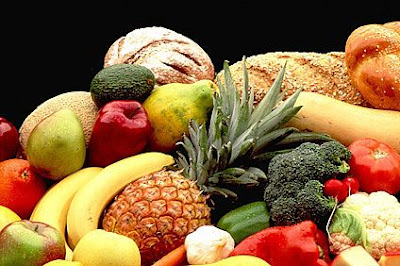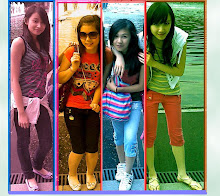
-shorter wavelengths have more energy than longer ones
-wavelengths shorter than visible light can damage organic molecules
Pigments + Color
-a substance's color is cause by chemical compounds called pigments
-when light shines on material with pigments, the wavelengths can be absorbed, transmitted or reflected
-pigments in chloroplasts absorb blue-violet and red-orange light well
-chloroplasts convert the absorbed light energy into chemical energy
-but they cannot absorb green light well
-most of green light is transmitted through leaf or is reflected
-leaves look green because green light is not absorbed
Identifying Chloroplast Pigments
-using paper chromatography, you can observe pigments in a leaf
Procedure
1. Press leaf on filter paper
2. Seal paper in a cylinder containing solvents
-solvents will move up the paper
-different pigments will travel at different rates depending on how easily they dissolve and how much they are attracted to the paper
-chlorophyll a mainly absorbs blue and red light, and reflects green light
-plays big role in light reactions of photosynthesis
-there are "helper pigments" which absorb mainly blue and orange light reflects yellow-green light

Harvesting Light Energy
-in the thylakoid membrane, chlorophyll and other molecules are arranges in the groups calles photosystems
-each photosystem contains a few hundred pigment molecules (including chlorophyll a, and b)
-act like light gathering panel
-each time pigment molecule absorbs energy, one of the pigments electrons gains energy
-becomes at an "excited stage"
~unstable
~almost immediately goes back to normal (ground stage) and transfers energy to a molecule next to it
~when at ground state, it "excites" another pigment molecule and that keeps going down the line
~energy jumps from molecule to molecule until it arrives at the reaction center of photosytem
-reaction center: contains chlorophyll a molecute next to a primary acceptor molecule
-primary acceptor molecule traps the excited electron from the chlorophyll a molecule
-other molecules can then use energy to create ATP and NADPH

Chemical Products of Light Reactions
-two photosystems are involved in light reactions
-first photosystem:
traps light energy and transfers the excited electrons to an electron transport chain
electrons are replaces by a splitting molecule of water
release oxygen and hydrogen ions as waste products
-the electron transport chain releases energy for the chloroplast to make ATP
~connects the two photosystems
-is similar to cellular respiration
-electron transport chain pumps hydrogen ions across membrane
-light-excited electrons travel down the chain

-second photosystem:
produces NADPH by transferring excited electrons and hydrogen ions to a carrier molecule called NADP+

-input of light energy is shown by the large yellow mallets
-light energy makes electrons excited at the top of the platform in each photosystem
-energy released as the electrons move down the electron transport chain
-photosystems is used to pump hydrogen ions across a membrane and produce ATP
-light reactions convert chemical energy to NADPH and ATP
Concept Check 8.2
1. Explain why a leaf appears green.
A leaf looks green because the chloroplast pigments don't absorb the green light good, so the green light relflects back on the leaf.
2. Describe what happens when a molecule chlorophyll a absorbs light.
When it molecule chlorophyll a absorbs light, one of its pigments gains energy and become "excited". The "excited" stage is very unstable, so it almost instantly falls back down to the "ground stage" and transfers its energy to a neighboring molecule. This keeps going down the chain until the energy reaches the reaction center of the photosystem, which will capture the "excited" electron from the chlorophyll a molecule.
3. Besides oxygen, what two molecules are produced by light reactions?
ATP and NADPH are produces besides oxygen
4. Where in the chloroplast do the light reactions take place?
Light reactions take place in the in thylakoid membranes of the chloroplast.
~*~*~*~*~*~*~*~*~*~*~*~*~*~*~*~*~*~*~*~*~*~*~*~*~*~*~*~*~*~*~*~*~*~*~*~*~*~*~
Vocabulary for 8.1 + 8.2
chloroplast- cellular organism found in plant cells where photosynthesis occurs
chlorophyll- pigment that gives chloroplast its green color and uses light energy to split water molecules during photosynthesis
thylakoid- disk-shaped sac in the stroma, where light reactions take place
stroma- thick fluid inside the inner membrane of chloroplast
light reactions- chemical reaction that converts sun's energy to chemical energy
Calvin Cycle- cycle in plants that makes sugar from carbon dioxide, high-energy electrons carried by NADPH
wavelength- the distance between two waves that are next to each other
electromagnetic spectrum- range of electromagnetic waves
pigment- chemical compound that determines substance's color
paper chromotography-technique used to observe different pigments in material
photosystem- cluster of chlorophyll and other molecules in the thylakoid



![chloroplast[1].jpg](webkit-fake-url://A560946B-9FB6-4A83-9475-DF3DF6032A4A/chloroplast%5B1%5D.jpg)





